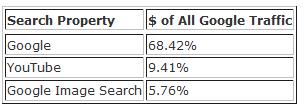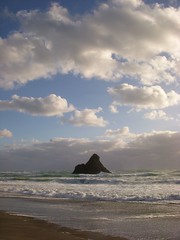Texas Stadium Demolition Case Study – YouTube Still Tops For Video Promotion
 Whenever I know I’ll be near some major spectacle, I try to photograph it or video it. Not only are such events great practice for a search marketer, the content is great for getting links from individuals and from newspapers. So, when I heard about the scheduled Texas Stadium Demolition, I couldn’t resist, even though it was painfully early in the morning (7:00 a.m.).
Whenever I know I’ll be near some major spectacle, I try to photograph it or video it. Not only are such events great practice for a search marketer, the content is great for getting links from individuals and from newspapers. So, when I heard about the scheduled Texas Stadium Demolition, I couldn’t resist, even though it was painfully early in the morning (7:00 a.m.).
I’ve written here before on how Flickr introduced videos in order to compete with the popular YouTube. Flickr’s owned by Yahoo, while Google owns YouTube.
Both services have a huge usership, however, (more…)
Possible Related Posts
Posted by Chris of Silvery on 04/11/2010
Permalink | |  Print
| Trackback | Comments (0) | Comments RSS
Print
| Trackback | Comments (0) | Comments RSS
Filed under: Image Optimization, SEO, Video Optimization Dallas Cowboys, flickr, image SEO, image-search, Texas Stadium, video search, video seo, videos, YouTube
Google Image Search – Second Only To Web Search In Size
This post is based on the interview between Eric Enge and Peter Linsley, Google’s Product Manager for Image Search. It reveals some interesting aspects of image search which is growing at an accelerated pace.
A recent survey by Hitwise in February 2009 shows Google Image Search as part of the troika of top web properties owned by Google in terms of traffic and revenue.

Possible Related Posts
Posted by Ravi of Netconcepts Ltd. on 07/19/2009
Permalink | |  Print
| Trackback | Comments (0) | Comments RSS
Print
| Trackback | Comments (0) | Comments RSS
Filed under: Best Practices, Google, Image Optimization, Search Engine Optimization, Searching, SEO alt text, auckland search engine optimisation, auckland seo, combating spam in image search, facial recognition software, Google-Image-Search, googlelabs, growth of image search, image search results, image-search, matching image with content, Netconcepts, on page factors in optimising images, ranking of images, signals in html world, signals in image world, similar images, universal search results, web page strength
Speaking at Dallas WordCamp 2009
 I’m speaking at this year’s WordCamp in Dallas again later this week.
I’m speaking at this year’s WordCamp in Dallas again later this week.
WordCamp is a mini-convention for WordPress and blogging enthusiasts. Some of the content is WordPress-centric, but other content is applicable to bloggers in general, such as how to promote your blog and other stuff.
I’ll be speaking on how to use social image sharing services for promotion. Social media sites such as Flickr allow people to publish and share their photos with many other people, and the site is well-constructed in terms of search engine optimization, so posting images there helps get media distributed all over. Using Flickr can help one gain more attention, inbound links, and overall search rankings.
I’ve spoken on using Flickr for promotion and optimization before, and I’ve written on details of image optimization here a number of times.
I’d further recommend blogging to everyone – I first started blogging here on the Natural Search Blog as a guest, after Stephan Spencer invited me, and it eventually changed my overall career path. Be sure to check out Stephan’s articles on blog optimization, btw, since he’s pretty much the top authority out there on the subject.
There’s still a few seats left for Dallas WordCamp – sign up before they’re all gone!
Possible Related Posts
Posted by Chris of Silvery on 06/22/2009
Permalink | |  Print
| Trackback | Comments (0) | Comments RSS
Print
| Trackback | Comments (0) | Comments RSS
Filed under: Blog Optimization, Conferences, Content Optimization, Image Optimization, SEO, Social Media Optimization Blog Optimization, blog seo, blogging, dallas wordcamp, flickr, Image Optimization, image SEO, Image-Search-Optimization, SMO, Social Media Optimization, Social-Media, word camp, wordcamp, WordPress
Flickr *IS* Good for Search Marketing – Despite Naysayers!
I’ve seen a recent article or two claiming that Flickr can no longer be leveraged for SEO purposes. As frequent readers here know, I’ve long been a proponent of using Flickr, both for its great Web 2.0 features, but also for its marketing/promotional value. I’m sure I’m one of the people that article writer was thinking of when he mentioned hearing recommendations for use from other articles and search marketing conferences.
Flickr can still be a valuable source of internet promotion, and a great tool for the purposes of Image Search Optimization. Read on and I’ll explain. (more…)
Possible Related Posts
Posted by Chris of Silvery on 01/14/2009
Permalink | |  Print
| Trackback | Comments (0) | Comments RSS
Print
| Trackback | Comments (0) | Comments RSS
Filed under: Image Optimization, Marketing, Search Engine Optimization, SEO flickr, image SEO, image-search, SEO
Google Photos To Compete With Flickr?
The Google Operating System blog reports that Google is likely changing the name of their Picasa photo sharing service to “Google Photos”.
A few other features are due to rollout as well, including licensing options, email photo uploads, and tagging of people in pics. (more…)
Possible Related Posts
Posted by stephan of stephan on 07/01/2008
Permalink | |  Print
| Trackback | Comments Off on Google Photos To Compete With Flickr? | Comments RSS
Print
| Trackback | Comments Off on Google Photos To Compete With Flickr? | Comments RSS
Filed under: Google, Image Optimization flickr, Google, Google Photos, image sharing, Picasa
New Ranking Methodology for Google Image Search
The New York Times is reporting on a new research paper about Google’s new image ranking algo which apparently associates an inferred linking relationship between images and uses the PageRank method of iterating ranking values across the graph to come up with final ranking values. This “VisualRank” method was presented in a paper at the International World Wide Web Conference in Beijing this past Thursday, and the process was also reported at Techcrunch.

Google’s advancements in Image Search
could help keep high-value image results
like this coastal pic stay high in the SERPs
for apropos keywords, while making less-
important images rank far lower.
The new methodology is apparently very adept at weeding out less-important and less-useful images from the search results.
I have earlier reported on Google’s research into Supervised Multiclass Labeling (“SML”) which can assist with associating keywords with the actual content found within digital images. See also Search Engine Land’s article on Google’s VisualRank Paper.
Possible Related Posts
Posted by Chris of Silvery on 04/28/2008
Permalink | |  Print
| Trackback | Comments Off on New Ranking Methodology for Google Image Search | Comments RSS
Print
| Trackback | Comments Off on New Ranking Methodology for Google Image Search | Comments RSS
Filed under: Google, Image Optimization Google, image-search, Image-Search-Optimization, VisualRank
Flickr As New YouTube Killer?
Michael Arrington at Techcrunch reports that video is coming soon to Flickr.
This is great news, and I think it could become an overnight major competitor to YouTube — having both types of media available via one site/service makes for a lot of convenience.
Though, people may not realize that it’s already been possible to a small degree, if you upload an animated GIF to Flickr (see this example where I uploaded an animated sequence of a glider’s movement from Conway’s Game of Life).
Possible Related Posts
Posted by Chris of Silvery on 03/17/2008
Permalink | |  Print
| Trackback | Comments Off on Flickr As New YouTube Killer? | Comments RSS
Print
| Trackback | Comments Off on Flickr As New YouTube Killer? | Comments RSS
Filed under: General, Image Optimization flickr, Yahoo, YouTube
Google’s Ranking Advice in Blended Search at SMX West
 Just a quick post here on some simple tips that David Bailey of Google advised in this morning’s session on “The Blended Search Revolution” at the SMX West conference in Santa Clara:
Just a quick post here on some simple tips that David Bailey of Google advised in this morning’s session on “The Blended Search Revolution” at the SMX West conference in Santa Clara:
- Publish high-quality, well-captioned images;
- Have pages which already have good PageRank (use traditional SEO to achieve);
- Create a Google Video Sitemap;
- Update business listings in Local Business Center;
- Submit your feed to Google Product Search;
- Create a high-quality company blog;
Possible Related Posts
Posted by Chris of Silvery on 02/26/2008
Permalink | |  Print
| Trackback | Comments Off on Google’s Ranking Advice in Blended Search at SMX West | Comments RSS
Print
| Trackback | Comments Off on Google’s Ranking Advice in Blended Search at SMX West | Comments RSS
Filed under: Conferences, Content Optimization, Google, HTML Optimization, Image Optimization, Local Search Optimization, PageRank, Search Engine Optimization, SEO blended search, David-Bailey, Google, SEO, SMXWest08, Universal-Search
Flickr Starts Nofollowing
 A couple of my colleagues, Brian Brown and Jeff Muendel, identified that Flickr has begun NOFOLLOWing hyperlinks in their photo profile pages. I’ve confirmed this and have a few more details to add. (more…)
A couple of my colleagues, Brian Brown and Jeff Muendel, identified that Flickr has begun NOFOLLOWing hyperlinks in their photo profile pages. I’ve confirmed this and have a few more details to add. (more…)
Possible Related Posts
Posted by Chris of Silvery on 02/21/2008
Permalink | |  Print
| Trackback | Comments Off on Flickr Starts Nofollowing | Comments RSS
Print
| Trackback | Comments Off on Flickr Starts Nofollowing | Comments RSS
Filed under: Image Optimization, Link Building, PageRank, Search Engine Optimization, SEO flickr, image SEO, Image-Search-Optimization, Search Engine Optimization, SEO
Google Hiding Content Behind an Image on their SERPs
Tamar Weinberg at Search Engine Roundtable reports that in a Google Groups forum, a Webmaster Central team member stated that you could use something like the z-index attribute in DHTML styles to hide text or links behind an image, so long as the text/link being hidden is what’s represented in the image.
I think it’s a good thing that they do allow this sort of use, because it appears to me that they’re doing this very thing on their own search results pages! If you refresh a search page, you can see what they’re hiding under their own logo:
…a text link pointing to their homepage.
Now, the interesting question I’d have for the Google team about this would be: this is straightforward if the image itself contains text, but what would be allowable if the image doesn’t contain text, but say, an image of a lion? There’s many different ways to express what that lion is from “lion” to “tawny, golden-furred lion king”.
Or, should we be assuming that images that are written over text and links are only allowable when the image contains text?
The Google Webmaster Tools contributor states that you could be using image’s ALT and TITLE attributes to essentially do the same thing. This is sorta funny, because one could say the same thing of Google’s use of this on their own page — why are they doing it?
One immediately wonders how Google polices this, since they’re apparently not frowning upon pages drawing images over text/links in all cases. They can detect text written over images, but would they have every instance checked by a human? Or, are they using optical character recognition algos to automatically check the text within images against the text being hidden?
In any case, the fact that Google is doing this on their own site could be taken as more confirmation that they don’t consider the technique to be bad in of itself — as long as the practice is conservative and the text/link just describes the text content within the image.
Possible Related Posts
Posted by Chris of Silvery on 11/19/2007
Permalink | |  Print
| Trackback | Comments Off on Google Hiding Content Behind an Image on their SERPs | Comments RSS
Print
| Trackback | Comments Off on Google Hiding Content Behind an Image on their SERPs | Comments RSS
Filed under: Google, Image Optimization, Search Engine Optimization, SEO Google, Search Engine Optimization, SEO, z-index, zindex


